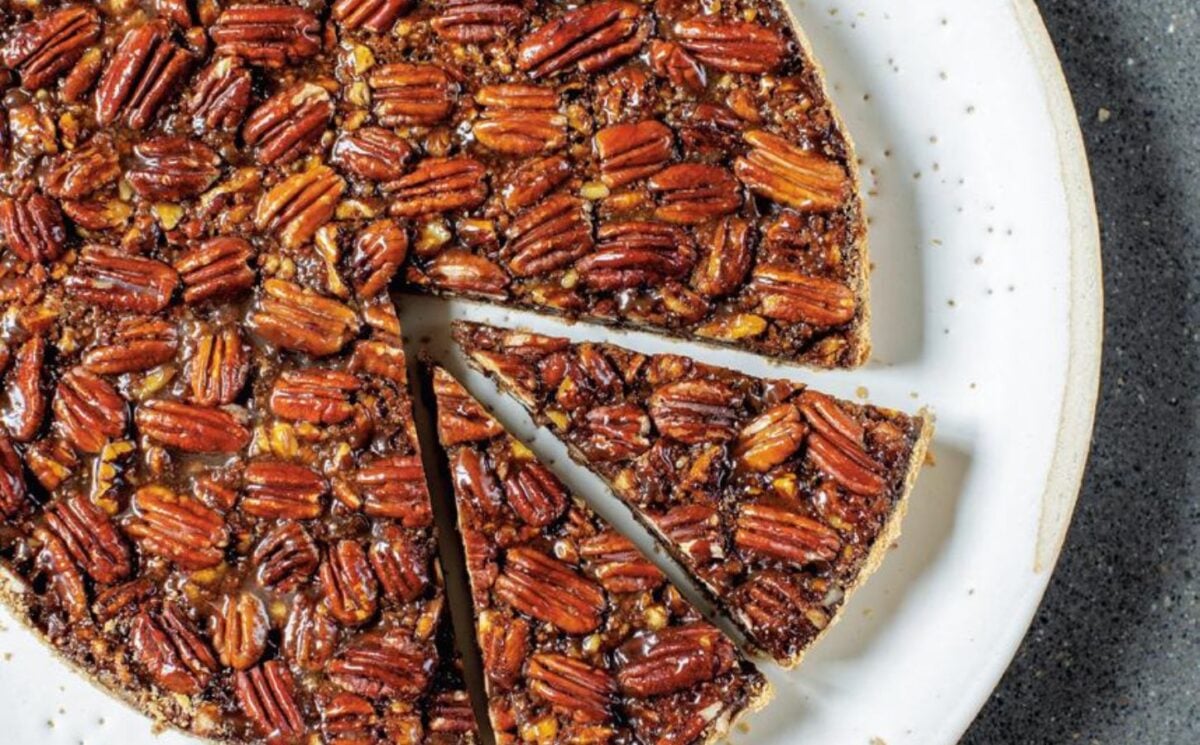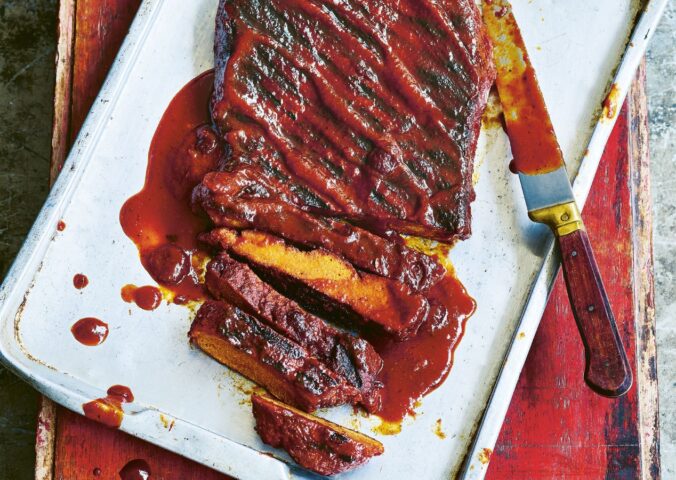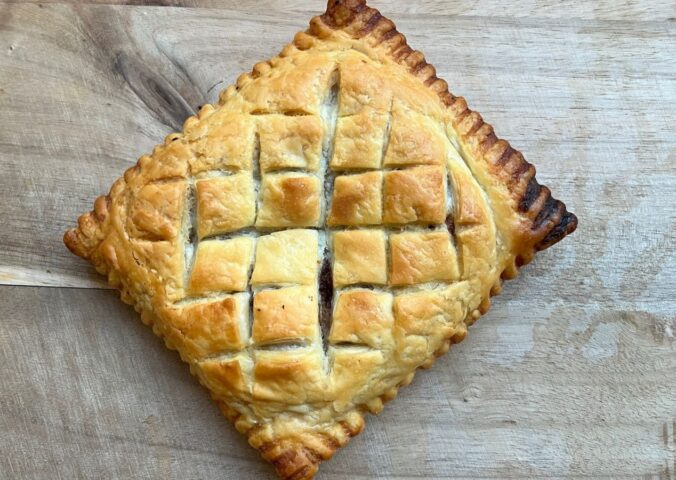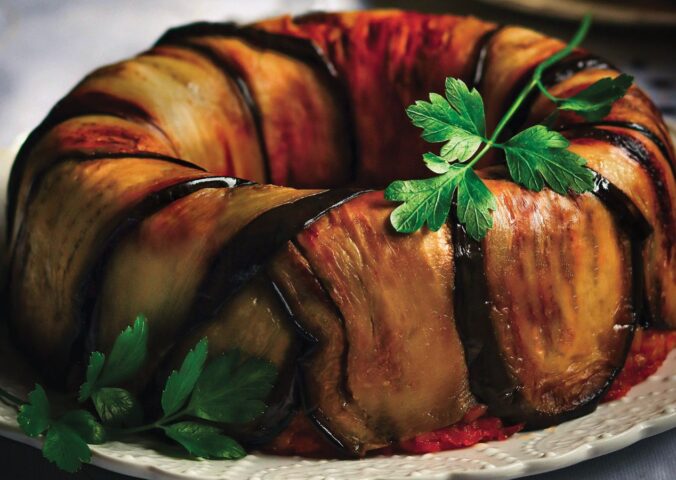If you are looking for a delicious and decadent vegan dessert to serve at your next gathering, look no further than this vegan maple pecan pie recipe. Created by a talented vegan baker and co-owner of BReD, Ed Tatton, this recipe takes inspiration from North American and British flavors to create a truly unique dessert.
Not only is it healthier than traditional pecan pie recipes, as it uses maple syrup in place of corn syrup, but it also tastes amazing and is sure to impress your guests. It is the ideal dessert for the holidays, especially for the Christmas season.
Is maple pecan pie vegan-friendly?
Pecan pie is usually not vegan-friendly. The shortcrust base may contain butter and the filling may contain eggs and more butter.
But it is possible to make a vegan version of maple pecan pie by using vegan butter instead of regular butter for the shortcrust base, and by using a vegan egg alternative, vegan butter, and cornstarch instead of eggs for the filling.
This fully vegan pecan pie recipe will guide you through the process of replacing the non-vegan ingredients with plant-based alternatives.
What can I use instead of corn syrup in a pecan pie?
Corn syrup is often used in pecan pie recipes as a sweetener and to create that wonderfully gooey filling. However, it has a high fructose content. You may therefore prefer to use an alternative sweetener.
There are several effective alternatives to corn syrup that you can use in a pecan pie recipe. Ed Tatton created this recipe using a mix of Canadian maple syrup, which has a similar consistency and sweetness to corn syrup, as well as golden syrup, which is made from sugar cane and has a rich, caramel-like flavor, and molasses for a deeper, more complex flavor.
What is so special about this vegan pecan pie recipe?
Not only is this pecan pie recipe completely vegan and made using healthier ingredients, but it was also created by the owner and baker behind BReD, a sourdough bakery in Whistler, Canada. He has drawn upon his British roots to create this fusion dessert, featuring a unique blend of golden syrup, molasses, and Canadian maple syrup.
BReD is known for its high-quality, artisanal baked goods, and this pecan pie recipe is no exception. When following their recipes, you will learn a lot of tricks and techniques that will help you become a better baker.
Discover more recipes by Ed Tatton:
Do you serve pecan pie hot or cold?
Traditionally, pecan pie is served at room temperature or slightly warmed, but some people prefer it chilled. If you prefer your pecan pie warm, you can reheat it in the oven or microwave before serving. However, be careful not to overheat it, as this can cause the filling to become runny or the crust to become soggy. If you prefer your pecan pie cold, you can refrigerate it for a few hours before serving.
Serving suggestions
This vegan maple pecan pie is delicious served on its own, but if you are feeling extra indulgent here are some serving suggestions that will elevate this dish:
- With a dollop of vegan whipped cream or coconut whipped cream on top of each slice
- Add a scoop of vegan vanilla ice cream or any non-dairy ice cream of your choice
- Drizzle on some vegan caramel sauce or chocolate sauce on top of each slice
Other vegan pie recipes
Maple pecan pie recipe

Ingredients
Sweet Shortcrust Pastry
- 110 g (½ cup) cold vegan butter cut into 1-inch (2.5cm) cubes
- 225 g (1¾ cups) whole wheat pastry flour
- 25 g (¼ cup) vegan icing sugar
- 2 g (¼ tsp) fine sea salt
- 25 g (2 tbsp) ice cold water
- 15 g (1 tbsp) extra-virgin olive oil
Filling
- 150 g (⅔ cup) vegan liquid egg such as JUST Egg
- 30 g (¼ cup) cornstarch
- 50 g (¼ cup) vegan butter melted
- 200 g (¾ cup) pure maple syrup
- 200 g (½ cup) golden syrup
- 50 g (2 tbsp) blackstrap molasses
- 25 g (2 tbsp) pure vanilla extract
- 100 g (¾ cup) sourdough breadcrumbs I recommend 100% rye
- 5 g (2 tsp) ground cinnamon
- 2.5 g (½ tsp) fine sea salt
- 250 g (2 cups + 2 tbsp) natural pecan pieces or chopped pecans
Decorating
- 100 g (¾ cup) natural pecan halves
Instructions
Make and blind-bake the pastry
- Place the bowl of a food processor in the fridge for 30 minutes before starting. This will help keep everything cold when making the pastry.
- Place the butter, whole wheat pastry flour, icing sugar, and salt in the chilled bowl of the food processor and pulse until combined, about 1 minute. Add the cold water and olive oil and pulse until a shaggy dough forms. Transfer the dough to an unfloured work surface and finish mixing by hand. Bring the pastry together into a ball with no dry patches.
- Gently roll the pastry between two 12 × 18-inch (30 × 45cm) pieces of parchment paper into a 5-inch (12cm) disc. (Rolling the pastry between the paper avoids using flour or icing sugar, which would change the flavor and texture of the pastry.) Transfer the pastry (between the parchment) to a baking sheet and chill in the fridge for at least 2 hours but ideally overnight. (By partly rolling the dough now, it won’t need to be worked as much to get it to the correct dimensions later. The pastry needs to stay as cold as possible to prevent splitting or shrinking, so flattening the dough now, rather than shaping it into a ball, is helpful.)
- When you are ready to bake, place a 10-inch (25cm) non-stick tart ring on a baking sheet lined with parchment paper or a silicone baking mat. (Alternatively, you can use a 10-inch/25cm round tart pan with a removable bottom and lightly rub butter on the bottom and sides.)
- Roll out the chilled pastry between the parchment paper into a 12-inch (30cm) circle, about ¼ inch (5mm) thick. Place the pastry back into the fridge and chill for at least 30 minutes.
- Working quickly and confidently, remove the top sheet of parchment paper. Gently flip the pastry over the tart ring (or tart pan) and carefully ease and press it into the corners. Return the pastry to the fridge and chill for 30 minutes.
- Meanwhile, preheat the oven to 340°F (170°C).
- Using a small knife, trim off the excess dough, leaving ½ inch (1cm) on the sides to allow for shrinking during baking. Keep the trim, covered and in the fridge, in case you need to make repairs later.
- Lightly prick holes all across the surface of the pastry with a fork. (This is called docking and allows steam to escape during baking, preventing the pastry from puffing up.) Line the pastry with a sheet of plastic wrap, leaving some overhang, and fill with baking beans, dried chickpeas, or rice. (This will weigh the pastry down to keep it flat.)
- Bake the pastry case until the edges are golden brown, 20 to 25 minutes. Remove the tart from the oven and carefully lift out the plastic wrap and beans. If there are any holes or tears in the pastry, use the reserved trim to patch them up. There must be no holes in the pastry, or the filling will run straight through it.
- Return the pastry case to the oven to bake until the base is light golden brown and any “repair” pastry has had a chance to bake a little, 5 to 7 minutes. Remove the baked tart case from the oven and set aside while you prepare the filling.
Make the filling and bake the pie
- In a large bowl, whisk together the vegan liquid egg and cornstarch until smooth. Add the butter, maple syrup, golden syrup, molasses, vanilla, breadcrumbs, cinnamon, and salt and whisk until smooth. Add the 250g (2 cups + 2 tablespoons) pecan pieces and mix with a rubber spatula.
- Pour the filling into the baked tart case and gently spread it to an even layer. Decorate the top with the 100g (¾ cup) pecan halves. Carefully transfer the pie to the oven and bake until the filling is golden brown and just set when jiggled – 30 to 35 minutes. Remove the tart from the oven and let cool on the baking sheet for 30 minutes.
- Using a serrated knife, carefully trim the excess pastry from the rim, cutting away from the tart to prevent the pastry from crumbling onto the filling. Remove the tart ring.
- Enjoy the pecan pie warm from the oven. Once it has fully cooled, store the pie in an airtight container in the fridge for up to 3 days.
Excerpted from BReD by Edward Tatton and Natasha Tatton. Copyright © 2023 Edward Tatton and Natasha Tatton. Photography by Janis Nicolay. Published by Penguin, an imprint of Penguin Canada, a division of Penguin Random House Canada Limited. Reproduced by arrangement with the Publisher. All rights reserved.
More like this:





